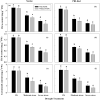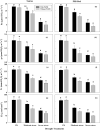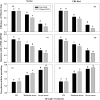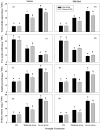Plant growth promoting rhizobacteria alleviates drought stress in potato in response to suppressive oxidative stress and antioxidant enzymes activities
- PMID: 33046721
- PMCID: PMC7550571
- DOI: 10.1038/s41598-020-73489-z
Plant growth promoting rhizobacteria alleviates drought stress in potato in response to suppressive oxidative stress and antioxidant enzymes activities
Abstract
Maintenance of plant physiological functions under drought stress is normally considered a positive feature as it indicates sustained plant health and growth. This study was conducted to investigate whether plant growth-promoting rhizobacteria (PGPR) Bacillus subtilis HAS31 has potential to maintain potato growth and yield under drought stress. We analyzed trends of chlorophyll concentration, photosynthesis process, relative water content, osmolytes, antioxidants enzymes and oxidative stress, relative growth rate, tuber and aboveground biomass production in two potato varieties, Santae (drought-tolerant) and PRI-Red (drought-sensitive). Plants of both genotypes were treated with 100 g of HAS31 inoculant at 10 days after germination and exposed to different soil relative water contents (SRWC), including 80 ± 5% (well watered), 60 ± 5% (moderate stress) and 40 ± 5% SRWC (severe stress) for 7 days at tuber initiation stage (30 days after germination). The drought stress reduced plant relative growth rate, biomass production, leaf area, number of leaves and tubers, tuber weight, and final yield. The drought-stressed plants showed decline in chlorophyll contents, membrane stability, leaf relative water contents and photosynthetic rate. Under drought stress, enzymatic activity of catalase (CAT), peroxidase (POD) and superoxide dismutase (SOD), contents of total soluble sugars, soluble proteins and proline increased. The application of PGPR reduced the impact of drought and maintained higher growth and physio-chemical traits of the plants. The plants with PGPR application showed higher relative growth rate, dry matter production, leaf area, number of tubers, tuber weight and yield as compared to plants without PGPR. The PGPR-HAS31 treated plants maintained higher photosynthetic process, contents of chlorophyll, soluble proteins, total soluble sugars, and enzymatic activities of CAT, POD and SOD as compared to plants without PGPR. The results of the study suggest that plant growth regulators have ability to sustain growth and yield of potato under drought stress by maintaining physiological functions of the plants.
Conflict of interest statement
The authors declare no competing interests.
Figures








Similar articles
-
Alleviation of drought stress by root-applied thiourea is related to elevated photosynthetic pigments, osmoprotectants, antioxidant enzymes, and tubers yield and suppressed oxidative stress in potatoes cultivars.PeerJ. 2022 Apr 7;10:e13121. doi: 10.7717/peerj.13121. eCollection 2022. PeerJ. 2022. PMID: 35415014 Free PMC article.
-
Regulation of antioxidant production, ion uptake and productivity in potato (Solanum tuberosum L.) plant inoculated with growth promoting salt tolerant Bacillus strains.Ecotoxicol Environ Saf. 2019 Aug 30;178:33-42. doi: 10.1016/j.ecoenv.2019.04.027. Epub 2019 Apr 13. Ecotoxicol Environ Saf. 2019. PMID: 30991245
-
The effect of calcium chloride on growth, photosynthesis, and antioxidant responses of Zoysia japonica under drought conditions.PLoS One. 2013 Jul 2;8(7):e68214. doi: 10.1371/journal.pone.0068214. Print 2013. PLoS One. 2013. PMID: 23844172 Free PMC article.
-
Evaluation of oxidative stress, biochemical parameters and in silico markers in different pea accessions in response to drought stress.Plant Cell Rep. 2024 Oct 5;43(10):251. doi: 10.1007/s00299-024-03311-x. Plant Cell Rep. 2024. PMID: 39367961 Review.
-
Silicon Mitigates Negative Impacts of Drought and UV-B Radiation in Plants.Plants (Basel). 2021 Dec 28;11(1):91. doi: 10.3390/plants11010091. Plants (Basel). 2021. PMID: 35009094 Free PMC article. Review.
Cited by
-
Effects of Zinc Oxide and Silicon Dioxide Nanoparticles on Physiological, Yield, and Water Use Efficiency Traits of Potato Grown under Water Deficit.Plants (Basel). 2023 Jan 3;12(1):218. doi: 10.3390/plants12010218. Plants (Basel). 2023. PMID: 36616345 Free PMC article.
-
Genome-wide identification, in silico characterization and expression analysis of the RNA helicase gene family in chickpea (C. arietinum L.).Sci Rep. 2022 Jun 13;12(1):9778. doi: 10.1038/s41598-022-13823-9. Sci Rep. 2022. PMID: 35697711 Free PMC article.
-
Zero budget natural farming components Jeevamrit and Beejamrit augment Spinacia oleracea L. (spinach) growth by ameliorating the negative impacts of the salt and drought stress.Front Microbiol. 2024 Mar 12;15:1326390. doi: 10.3389/fmicb.2024.1326390. eCollection 2024. Front Microbiol. 2024. PMID: 38533327 Free PMC article.
-
Growth kinetics, improved plant growth and alleviation of water stress in tomato by water stress tolerant bacteria.Antonie Van Leeuwenhoek. 2022 Dec;115(12):1437-1453. doi: 10.1007/s10482-022-01789-7. Epub 2022 Nov 12. Antonie Van Leeuwenhoek. 2022. PMID: 36369407
-
Role of Nanoparticles in Enhancing Crop Tolerance to Abiotic Stress: A Comprehensive Review.Front Plant Sci. 2022 Nov 2;13:946717. doi: 10.3389/fpls.2022.946717. eCollection 2022. Front Plant Sci. 2022. PMID: 36407622 Free PMC article. Review.
References
-
- FAO . Crop Prospects and Food Situation. Food and Agriculture Organization, Global Information and Early Warning System. Rome: Trade and Markets Division (EST); 2015.
-
- Lefe I, Legay S, Lamoureux D. Identification of drought-responsive compounds in potato through a combined transcriptomic and targeted metabolite approach. J. Exp. Bot. 2017;61:2327–2343. - PubMed
-
- FAO. How to Feed the World in 2050. Insights from an Expert Meet. FAO 2050, 1–35 (2009).
Publication types
MeSH terms
Substances
LinkOut - more resources
Full Text Sources
Medical
Miscellaneous

